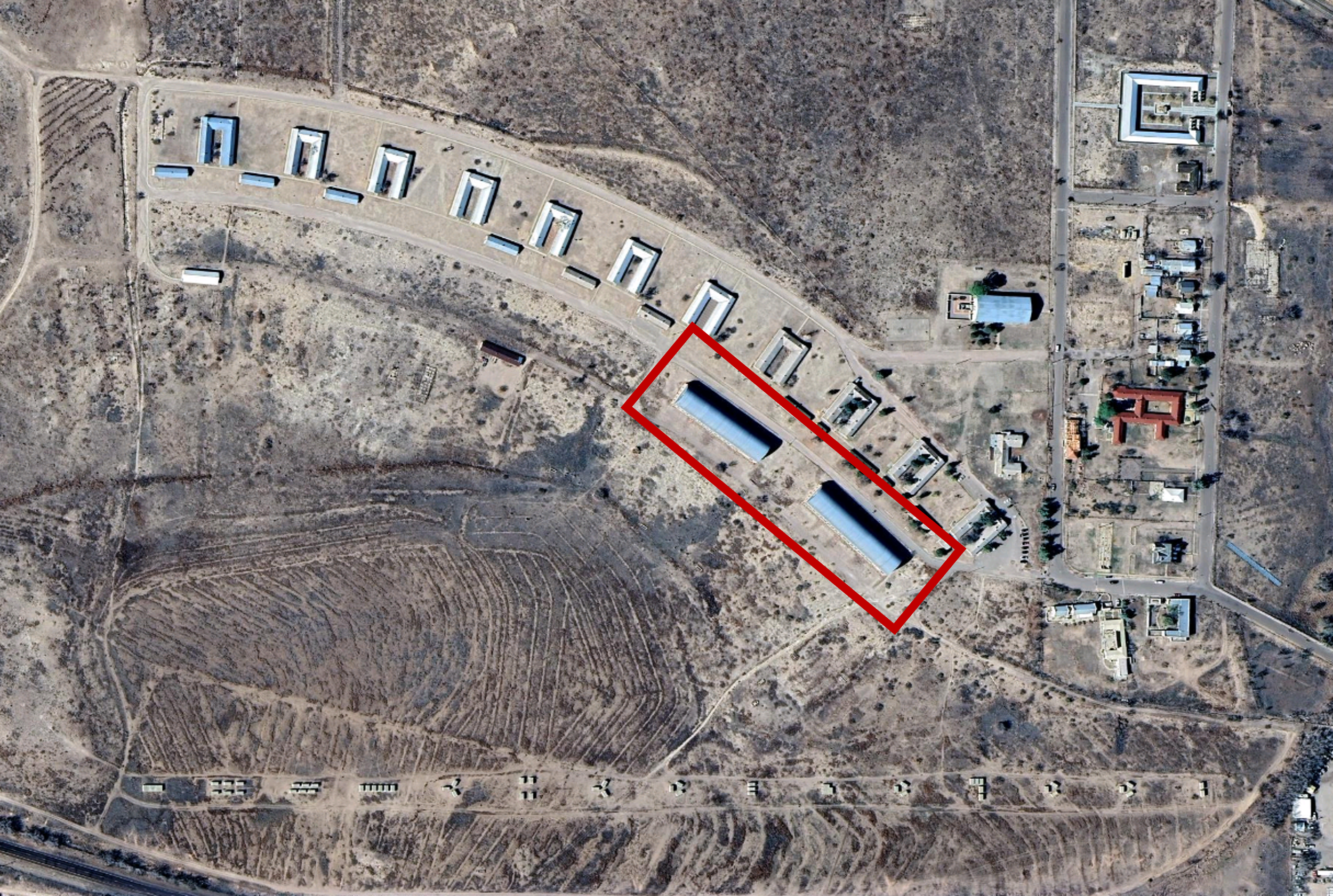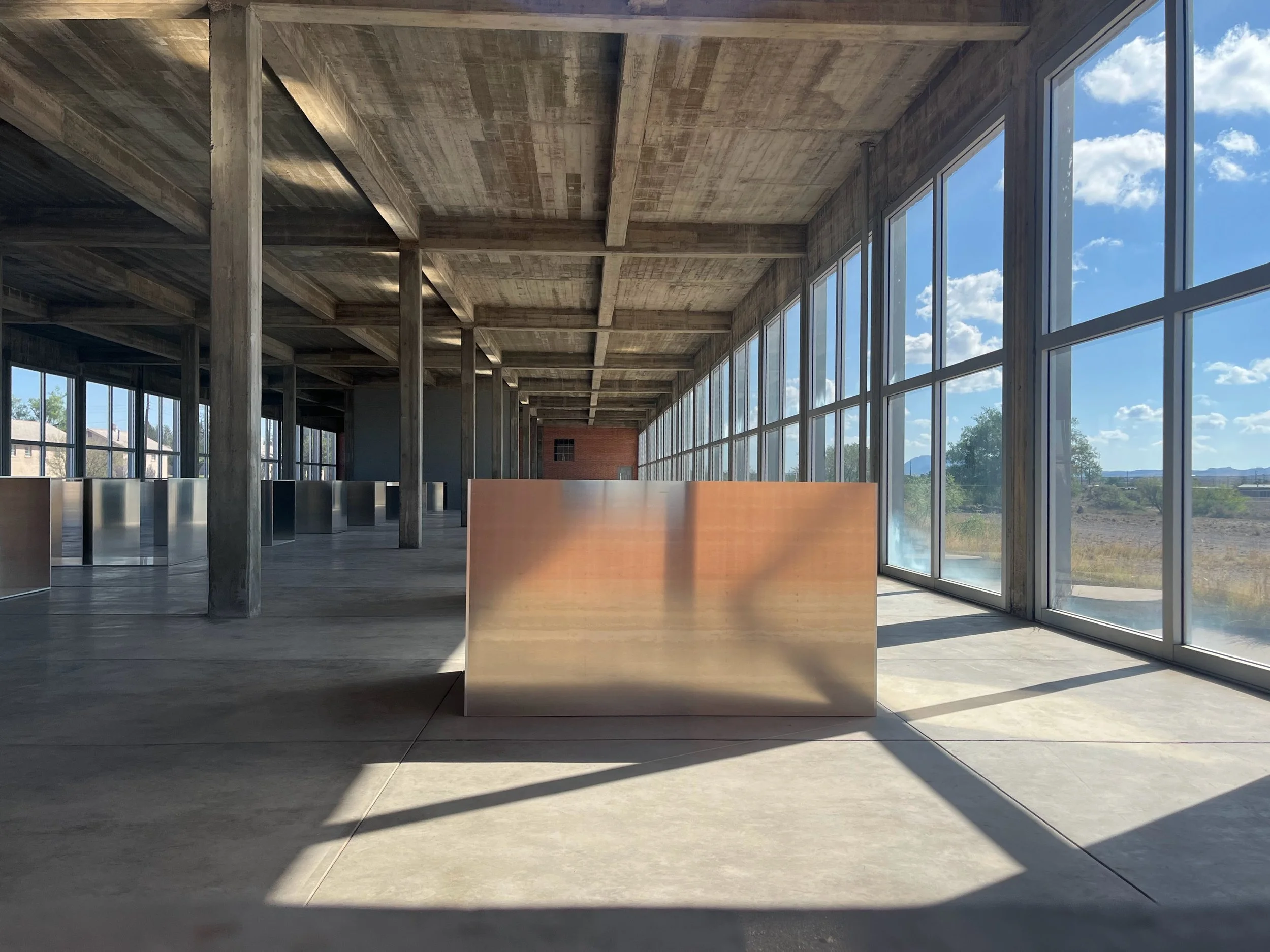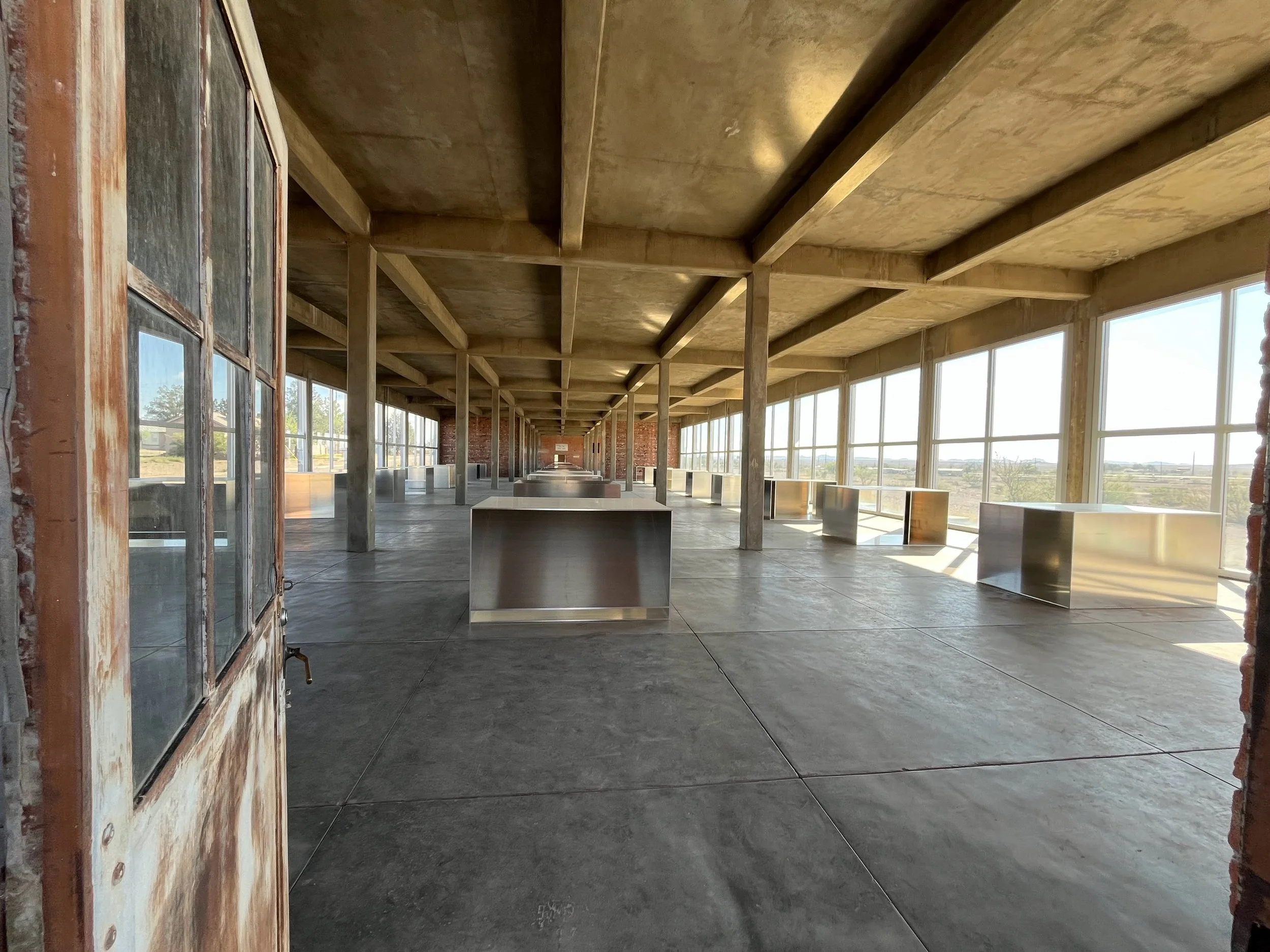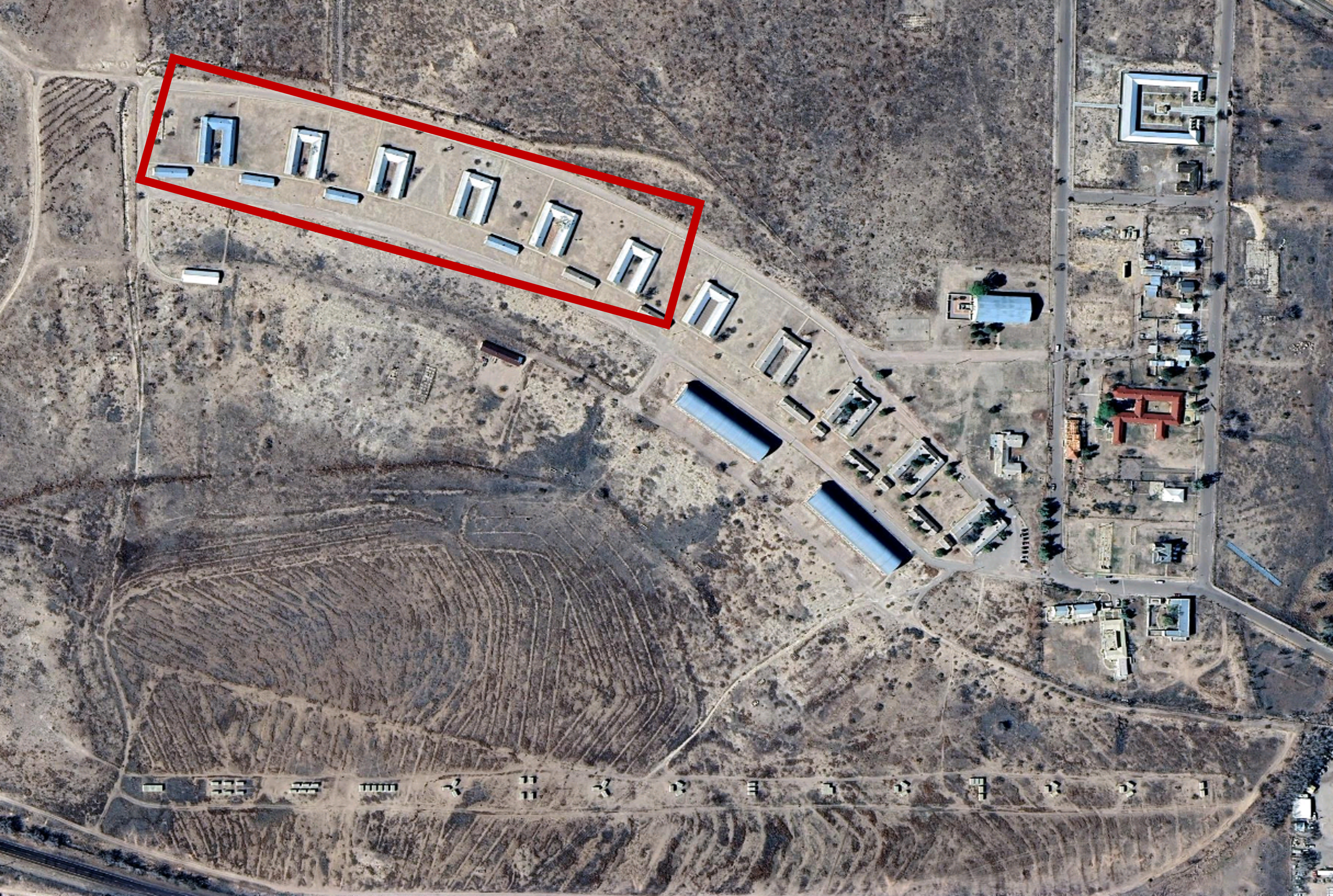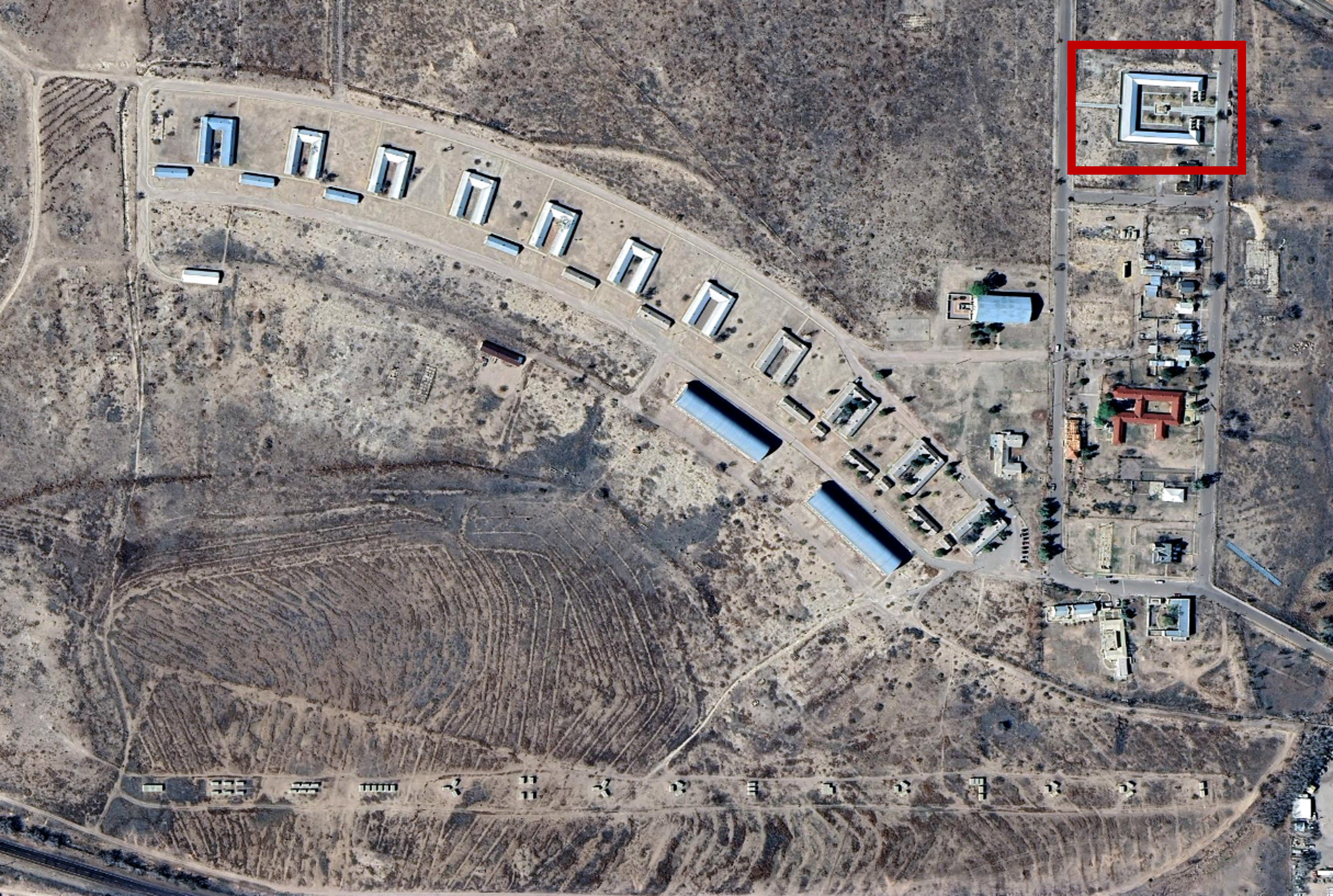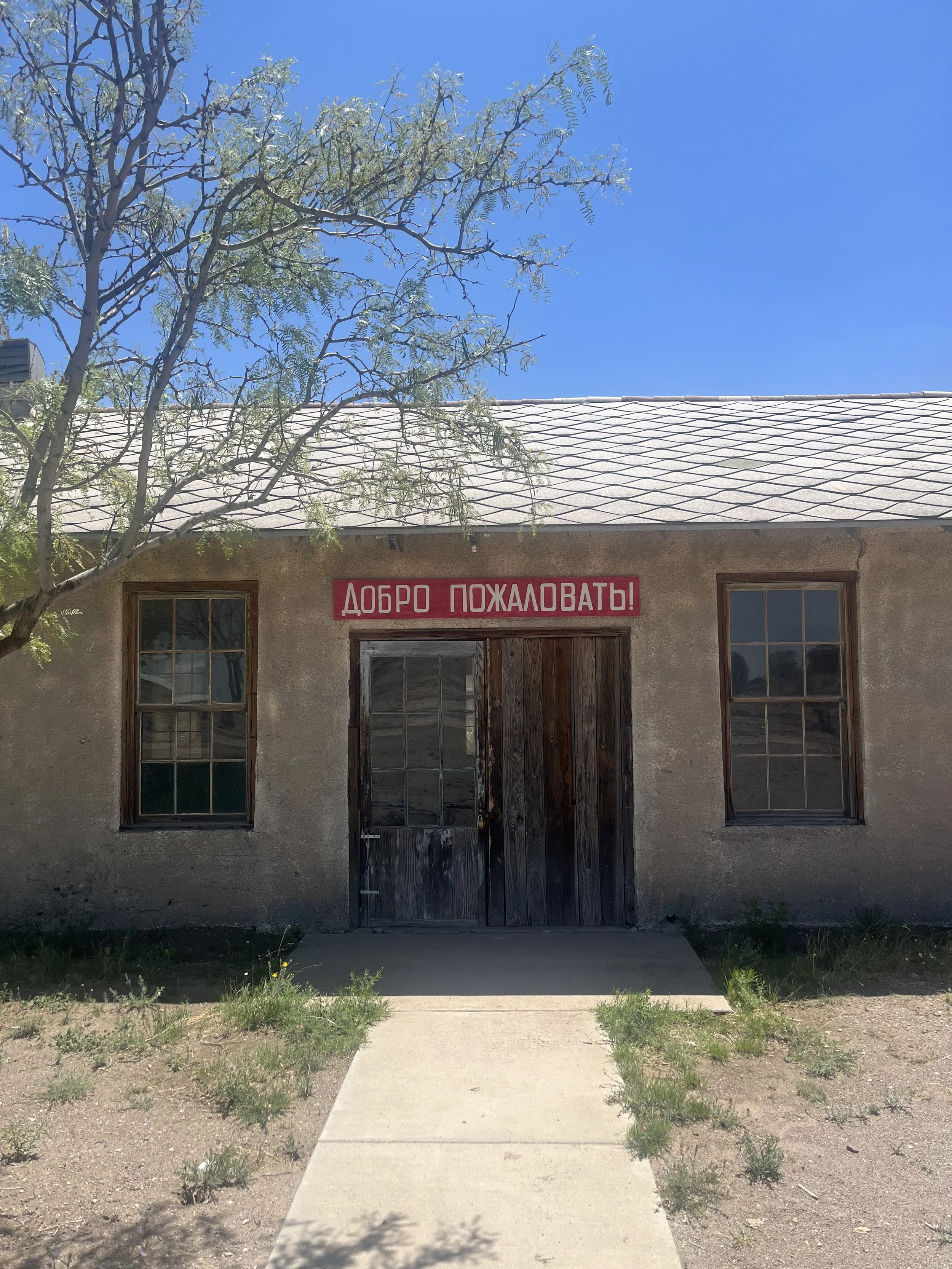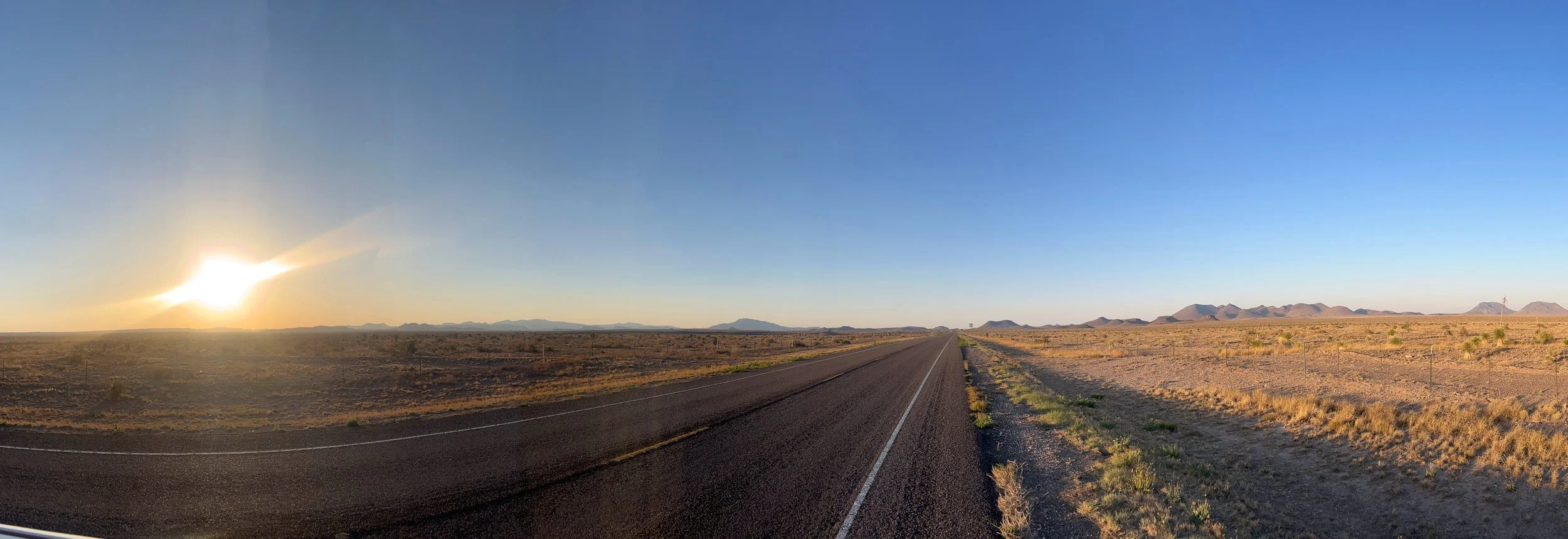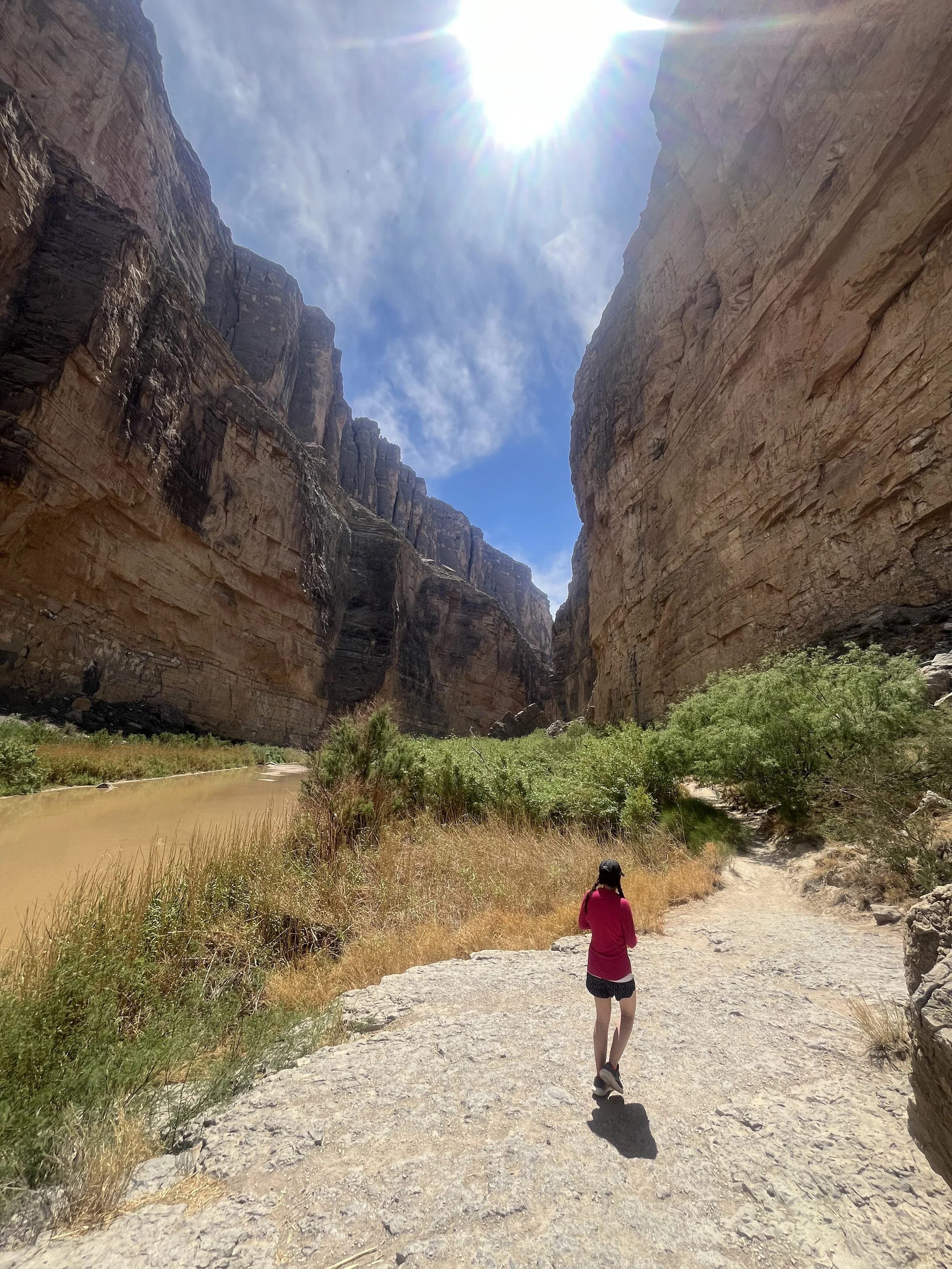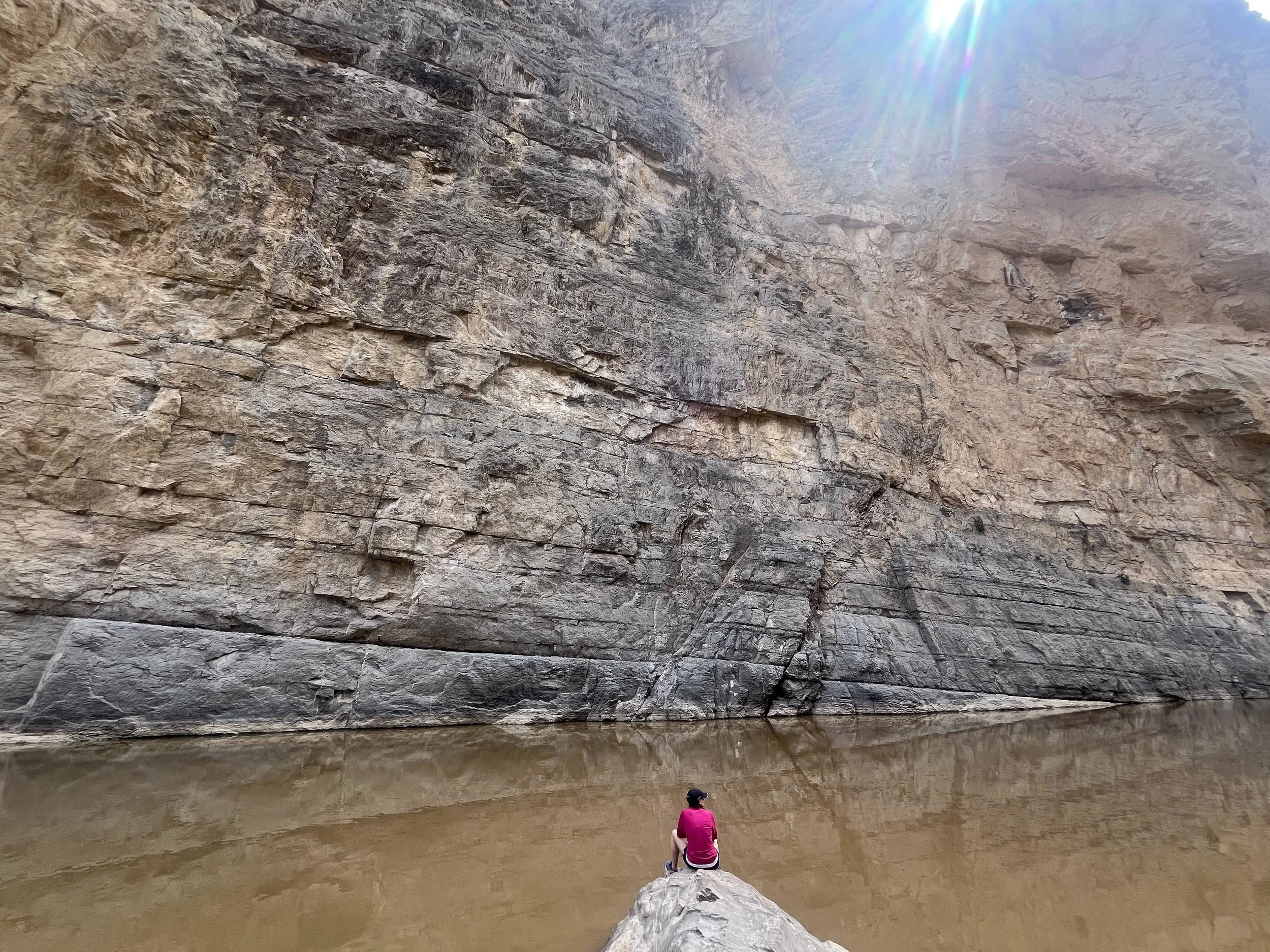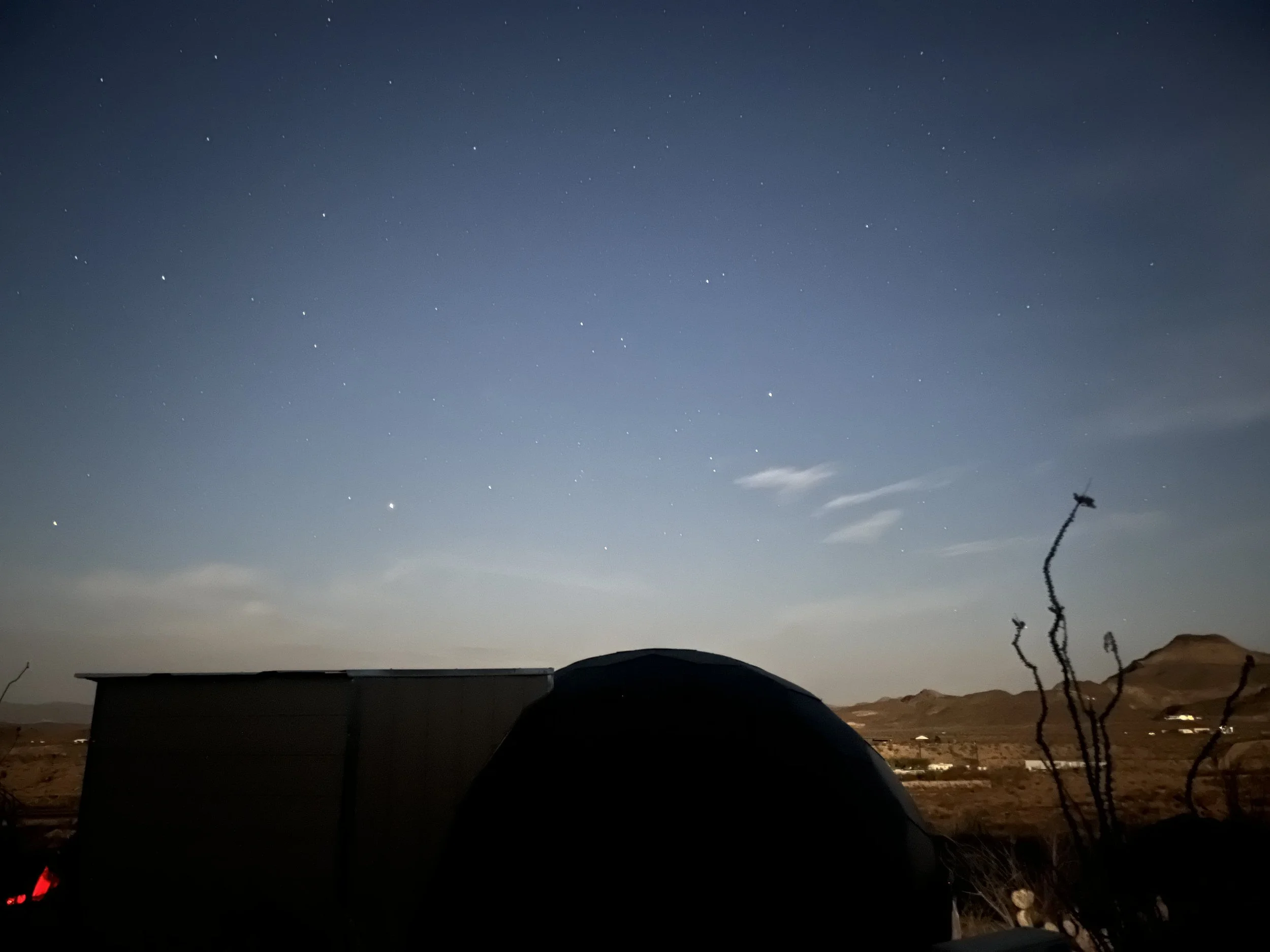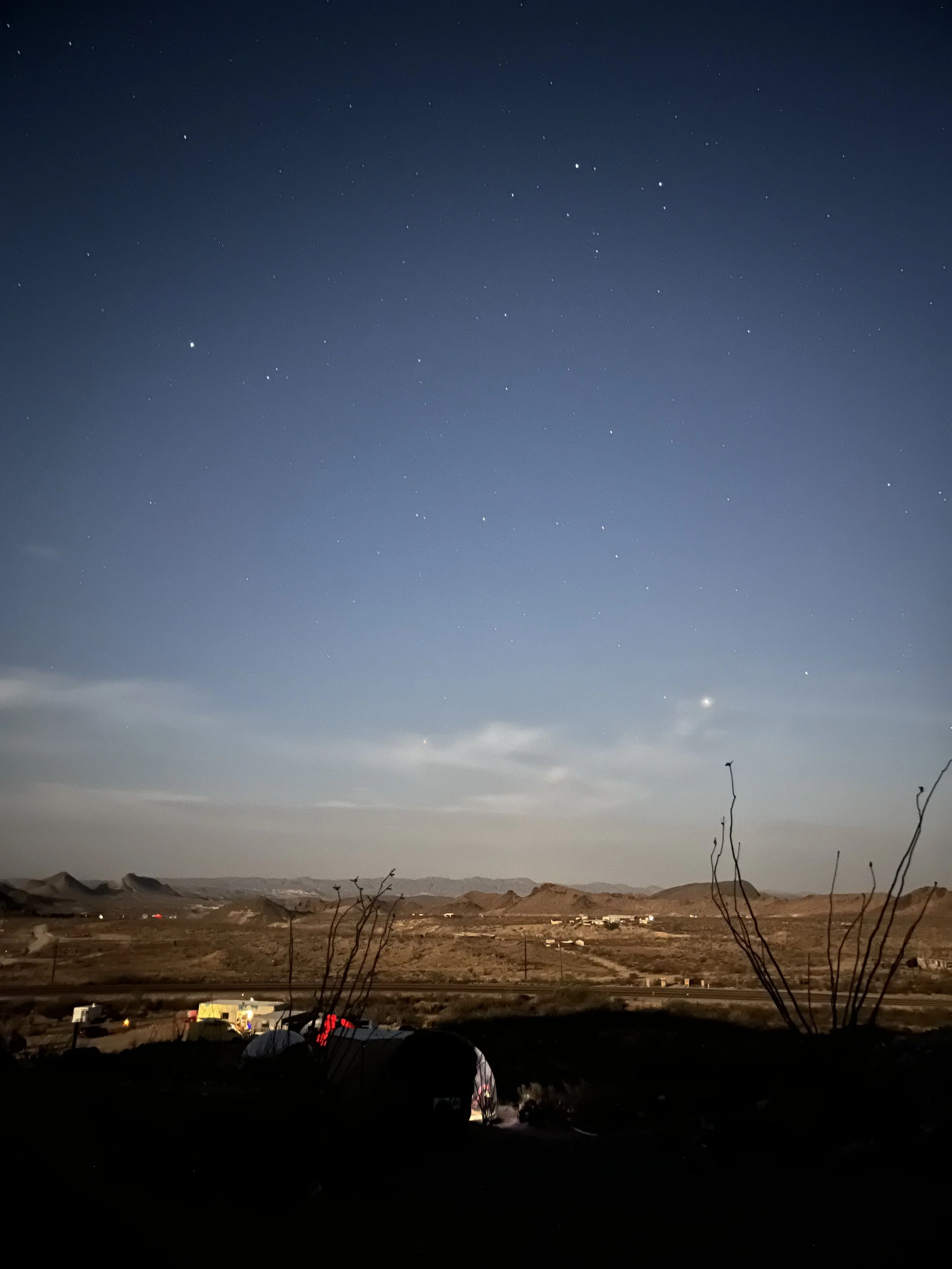
Donald Judd, 15 untitled works in concrete, 1980-1984
100 untitled works in mill aluminum, 1982-1986
& The Chinati Foundation
Marfa, Texas
May, 2025
Background
A special expanded feature, this will also feature other works at Chinati. Here’s a map of the whole museum, though it’s flipped 90 degrees, so north is to the right.
Let’s start with the main two, by Donald Judd:
Donald Judd, 15 untitled works in concrete, 1980-1984
This is one of Donald Judd’s most famous works. It consists of 60 concrete boxes, each measuring 2.5 meters high, 2.5 meters deep, and 5 meters wide, made from 25 centimeter thick panels. All the boxes share the same dimensions, but differ in which sides are open or closed, for example, some have one panel missing, others two. Judd grouped them into 15 sets and arranged them in a straight north-south line stretching about a kilometer along the eastern edge of the Chinati property. Each unit was cast and assembled on site. The work is a landmark of land art and minimalist sculpture, best appreciated from above to grasp its full scale, but from the ground you can really enjoy how each piece interacts with the landscape and each other.
“Most art is fragile and some should be placed and never moved again. Somewhere a portion of contemporary art has to exist as an example of what art and its context were meant to be. Somewhere, just as the platinum-iridium meter guarantees the tape measure, a strict measure must exist for the art of this time and place.”
Donald Judd, 100 untitled works in mill aluminum, 1982–1986
This is Donald Judd’s other major work at Chinati. It consists of 100 aluminum boxes, each with identical outer dimensions of 41 x 51 x 72 inches and ½ inch thick plates, but with interiors uniquely configured through variations in planes and openings (though a few might be mirrored versions of one another, I cannot confirm this, but in my viewing, I felt like I saw some repeats that were just flipped, but I could also just be bad at shapes). The works are installed in two converted artillery sheds. Judd transformed these industrial buildings by replacing the old garage doors with continuous walls of large square-paned windows that flood the space with natural light. He also added a vaulted galvanized iron roof above the original flat one, doubling the buildings’ height, with plans for glass ends to allow even more light. The boxes are distributed between the two sheds, roughly half in each, arranged with careful attention to light, space, and reflection.
“Well, I am not interested in the kind of expression that you have when you paint a painting with brush strokes. It’s all right, but it’s already done and I want to do something new.”
These 100 aluminum boxes each cost around $5,000 to fabricate, made by the Lippincott Company in Connecticut. That’s about $500,000 in manufacturing alone. Add in roughly $25,000 for shipping, $50,000 to purchase the two derelict artillery sheds, around $250,000 for installation, and about $2 million for renovations, and the total comes to just under $3 million in the 1980s. Adjusted for inflation, that’s about $7–8 million today, without a doubt, an extraordinarily ambitious and expensive undertaking. Each box gleams with precision, reflecting the light, the space, and each other beautifully.
Most of the boxes are arranged in the large main rooms, evenly spaced in three columns. Interestingly, though they’ve never been intentionally moved, the intense sunlight and heat have caused some to shift ever so slightly, or impressively given that it was only because of nature, inches over the decades. It stands as a subtle reminder of how nature quietly alters even the most controlled environments. Photography isn’t allowed inside, not for copyright reasons, but simply because people distracted by their cameras might easily bump into the art. And it’s true, with the playing of light, reflections, framing, and interactive spacing, it would be almost impossible not to, plus from a timing perspective, it would simply just slow the entire tour down greatly. Visitors are, however, allowed to take photos from outside the buildings.
The Chinati Foundation is also the home of around 11 other installations, depending on the year and temporary exhibitions or developments. It was founded in 1986 as an experiment in how contemporary art should be experienced. Originally a decommissioned military base, Fort D.A. Russell, Donald Judd transformed the sprawling desert campus into a permanent site for large-scale installations that integrate art, architecture, and the landscape. Dissatisfied with the way galleries and museums often presented his work, Judd envisioned Chinati as a place where both his and others’ artworks would be installed in direct dialogue with their surroundings, over years, unchanging, and in natural light.
The Dia Art Foundation played a crucial and formative role in the founding of the Chinati Foundation. I’ll try keep it brief, but there’s a lot of drama in the history (seriously, it was listed in this art world beef listicle, but if you want the full story, this article is the best one I found). Dia spent around $6M - $8M (or $20M - $28M adjusted for inflation in 2025) on the Marfa project and when Dia tried to end the contract early, they settled by giving Judd all of the assets.
Now that may have been too short given the story and the amount of research I’ve done. So, I’m going to dive into it a bit more. Skip ahead to the next bolded section if you don’t care anymore about this extended context. I recognize that I’m a bit biased. My summary is definitely going to lean in Dia’s favor… but whatever! Make your own conclusions.
Dia and Judd came to a deal in 1979 after a couple of years of discussion. The numbers are not concrete, but it seemed Dia spent around $6M - $8M (or $20M - $28M adjusted for inflation in 2025) acquiring land and buildings, salaries, operational expenditure, and funding renovations and art pieces. It is likely the acquisition of the land and buildings was much cheaper than the renovation and manufacturing of the art pieces themselves. I mean that’s one of the central reasons why Judd originally chose Marfa, land and buildings were cheap. In 1981, Judd pushed Dia to update their agreement. Formalizing the relationship further and increasing the commitment, with Judd’s salary increasing to $192K (or $640K adjusted for inflation in 2025). It is in my opinion that Judd was not easy to work with, but Dia’s deep pockets smoothed over any issues. This would all fall apart in 1983.
Dia was heavily funded Philippa de Menil and her donations of Schlumberger stock, an oilfield company, which in turn was heavily reliant on the price of oil. In 1983, slowly stagnating oil prices falling from their peak in 1980 of around $39.50 to the low $30s. And in 1985/1986 it would absolutely crater. These economic realities ended a decade of growth and patronage for Dia, which had spent $35 - $45M in this time period, and they needed to reel in their ambitions and renegotiate existing contracts to survive. Some artists understood that this was just an economic reality and thanked Dia and its members for support, others took it as a sleight and a broken promise. You can guess, that Donald Judd was in the latter group. A settlement was eventually reached where Judd would take all of the Marfa properties and investments in lieu of any other financial contribution. What I would give to be able to have seen this 3-4 year back and forth (screenplay idea!).
By 1987 Chinati had opened to the public with Dan Flavin’s installation of colored fluorescent light in six former barracks buildings; and John Chamberlain’s 25 sculptures in a renovated wool warehouse in downtown Marfa. Judd later expanded the collection over the next few years to include works by Claes Oldenburg and Coosje van Bruggen, Richard Long, Roni Horn, David Rabinowitch, Ilya Kabakov, and Ingólfur Arnarsson. Following Judd’s death in 1994, the museum completed additional projects: an installation of poems by Carl Andre (1995); a gallery of paintings by John Wesley (2004); and Robert Irwin’s untitled (dawn to dusk) (2016).
Chinati’s impact has helped transform Marfa into a destination for contemporary art. It set a precedent for site-specific, long-term installations and challenged conventional museum models. Its preservation of minimal and conceptual art in an immersive, spatially aware context has influenced generations. Chinati serves not just as a museum, but an enduring commitment to Judd’s principles. Its stark setting in the Chihuahuan Desert only amplifies that art here isn't merely displayed, it lives within the space, the light, and the land. Here are three others that I really enjoyed at Chinati as well, though unfortunately, none of which remotely photograph well, so please follow the links to see better images of them.
Dan Flavin, untitled (Marfa project), 1996
Flavin was such a close friend to Donald Judd, that he named his son after him. Unfortunately, they had a falling out regarding the fallout with Dia, but Chinati completed his works after Judd’s passing in 1994.
Flavin took six of the u-shaped former barracks and designed colored fluorescent light installations. Two parallel tilted corridors are constructed at the connecting central portion of each U-shaped building. These corridors contain light barriers that are placed either in the center or at the end of each corridor. The barriers consist of eight-foot-long fluorescent light fixtures, occupying the entire height and width of the corridor. The tubes are installed with space between them, allowing a view through the barrier. Each fixture holds two differently colored bulbs shining in opposite directions. The barriers in the six buildings utilize four colors: pink, green, yellow, and blue. The first two buildings use pink and green, the next two yellow and blue, and the last two buildings bring all four colors together. Two windows at the end of each long arm of the U allow daylight to enter the building and permit a view into the vast landscape. The fluorescent lights are standard sized tubes, but the interior colors are custom and limited. Chinati has the formula and mass orders replacements to justify the custom mix and ensure that it remains consistent both as lights are replaced and with the artist’s original intent.
Check out these galleries of the installations. It is a great use of the space, and are cool designs, but by the back half, you kinda get the point and at least I lost some interest. Still it’s a cool concept, great for color / light physics discussions.
“One might not think of light as a matter of fact, but I do. And it is, as I said, as plain and open and direct an art as you will ever find.”
Ingólfur Arnarsson, untitled works, 1991–1992
This one is very odd to describe. When you look at a the picture of it on the website it doesn’t seem like much and honestly, it isn’t. It’s the most subtle effort of 36 graphite drawings and 2 basically white canvases. It’s absurd and ridiculous, and would probably be laughed out of most museums. However, the building makes all the difference. The museum clearly has planned its tours so the lighting when you arrive in this room is perfect, but there’s no way to really describe it. I didn’t even bother to take a picture, because it wouldn’t make any sense. I’ve never seen something so plain seem so colorful. It’s continually hard to describe, it’s just slightly off white rectangles in a white room. But it is lit only by natural light coming in from one side. And I’m no physicist, but the light does something odd to it. Here’s a picture I found online that sort of captures the interaction. The room in itself is basically this subtle rainbow, and I’ll say it again… it doesn’t make any sense to describe it. You just have to go see it. It’s this simple art piece that has found the perfect room / building to exist in and it feels entirely in harmony. You walk in and you can almost feel the peace. It reminds me of Troy from Community exploring the Air Conditioning Repair school, and experiencing The Room Temperature Room. I didn’t even both taking a picture of it (we were limited to outside the building, and it just couldn’t do it even the remote justice…
Here is Marianne Stockebrand’s full description / review of the artist and this work in particular.
“Ingólfur Arnarsson’s works suggest to me an expression of light, lightness and infinity. They give the fragile impression of Japanese porcelain and thereby protect themselves by making the spectator wary of touching them. Pristine delicacy is a characteristic of both his paintings and drawings.”
Robert Irwin, untitled (dawn to dusk), 2016
Irwin had been developing and refining a design for the long-abandoned former army hospital site since 1999. Situated adjacent to the museum’s campus, the site was a C-shaped concrete structure, lined on all sides with a long sequence of windows that surrounded a central courtyard. The newly constructed building is cut into the existing slope, retaining the same physical relationship as the former building. Antechambers to the right and the left are open to the sky, referencing the historic structure’s previous ruined state. The former site had long been floorless, its windowsills eye level. The raised windowsills of the new building echo this, offering what Irwin described as “Dutch landscape like” views of the surrounding West Texas land and sky. The courtyard has been made into a garden defined by concrete paths running along Corten steel-lined raised beds and two rows of honey mesquite trees. Niches with benches flank the central planter, where Irwin has created a tableau of large basalt columns. It is also Irwin’s largest work to date, and represents the culmination of his decades-long investigation into the act of perception through manipulation of space and light.
Now the really cool part of this one is that the building is formally divided in half, with one side dark, the other light. Inside, transparent scrim walls are stretched taut from floor to ceiling in black or white respectively, bisecting each long wing and capturing the always-changing natural light. The connecting corridor has a progression of scrim walls that sequentially cross and fill the space, with an enfilade of doors for passage. No pictures are allowed inside because of the delicate nature of these scrim (people have a habit of bumping into things and ruining them if they’re focused on their device) and given that they are large, custom made, single pieces. It would be an expensive hassle to replace. And yes, I’ve used the word scrim three times in this passage, and I’ve never heard that word before visiting this, so welcome to the club. Watch this cool video from PBS that really demonstrates the coolness of the space, and they also use the word scrim a lot. The video does a great job of showing you that transition into the light side. Similar to Arnarsson’s it just changes interacts so well with the lighting its mesmerizing.
“That the light strikes a certain wall at a particular time of day in a particular way and it’s beautiful – that, as far as I’m concerned, now fits all my criteria for art. Aesthetic perception itself is the pure subject of art. Art existed not in objects but in a way of seeing.”
I forget which side was light and dark, my memory fails me, but I believe the left side was dark and the right was light. Though there’s a chance I’m saying this just because of the way the first window on each side is lit, you can see through the window on the right.
There’s obviously much more to Chinati, but those are my highlights. The Russian school room is random, there’s an event space, a bunch of other exhibitions, and some random pieces throughout the property.
Travel
The Chinati Foundation is the main feature of Marfa, Texas. The town is a 3 hour drive from either El Paso International Airport or from Midland International Air and Space Port. It is wildly inconvenient as both airports are basically regional, so you’ll likely have to layover somewhere to even get to one of them. You can technically fly to Marfa but you’ll need a private plane, and I have no idea how that works. You can also take an Amtrak train there, but I assume service is rather rare.
Marfa as a town is not very large. You can drive across in a couple minutes, so everything is pretty accessible. I would suggest renting a vehicle for getting around, but it’s possible to walk around since everything is relatively close. The Chinati Foundation is probably the farthest place you would walk to, just to the south of the town, it would take you about 20-25 minutes. There’s plenty of free parking on site.
There is a visitors center at the entrance, with a store and restroom. We bought a shirt, coffee table book, and some postcards for $87.48. Still ruing not purchasing a sweet dad hat too…
Hours & Locations – The Chinati Foundation
Complimentary access to Donald Judd’s 15 untitled works in concrete is available Wednesday through Sunday, from 9 a.m. to 5 p.m., with last admittance at 4 p.m. This piece is just east of the parking lot, and you can just walk down to them and walk around the grounds.
There are three types of tours to go on to visit the bulk of the Foundation’s works; the full collection tour, selections tour, and focus tours. They range from $15 - $35, so you might as well just do the full collection, like we did. However, keep in mind that none include the 15 untitled works in concrete, you have to schedule your own time, either before or after to see that. We decided to do the Full Collection 6 hour tour one day, and then returned the following morning to visit Judd’s concrete installation. Given there isn’t a ton of stuff to do in Marfa, I think this was a good itinerary. The 6 hour tour also includes some time for a lunch break. The after lunch portion is pretty light, being only the Robert Irwin and John Chamberlain building downtown (where the tour ends).
Our guide, (we’re having trouble confirming his name) I thought it was Dylan and Mattos recalls Damian, was excellent. Giving us plenty of information, without being over the top and unnecessary. Turning the tour into a great conversation and experience. His style, both outfit and car, is incredible, you’ll be able to spot him anywhere in Marfa.
Book your tickets well in advance of your trip because the reviews often say that it sells out. I wouldn’t say you need to be too quick about it, they weren’t slammed, but might as well book it when you know you’re going to be there. It’s definitely the main attraction.
It’s a lot of walking, and you’ll be outside for a large portion of it, so plan apparel and sun protection accordingly. We were there in a heat wave in May, so we brought a good amount of water, we can’t recall if we were allowed to bring it with us on the tour itself, but it doesn’t hurt to try, you can always leave it in your vehicle or the front desk.
Definitely hit up some of the galleries and shops in town. Ballroom Marfa is an easy and free one to check out. They are the owners of Prada Marfa, which I feature in this other post. We stayed for three nights at an Airbnb which we really enjoyed. It was off in the outskirts and was really quiet and peaceful, however, the reverse side to that was that we didn’t stay out in Marfa and try as many of the bars and other establishments that we wanted to try. We went to Cactus Liquor and picked up drinks for ourselves to have at the Airbnb. They are well stocked and very friendly. There are hotel options downtown as well, but we found them to be more expensive, so we opted to save a few bucks and go with Airbnb.
Mattos highly recommends trying the Mafa Lights Viewing Area. It’s just outside, and you’ll have to drive there, but it’s worth checking out late at night. Try not to be too loud and respect that people want it to be dark, so limit light usage. We spent about a half hour out there, and didn’t see anything. Bring a blanket or jackets to stay warm, it definitely can get chilly.
We also highly recommend taking a dip and hanging out at the Saint George Pool. It’s directly downtown and easy to get to. It is $30 per person for a day pass, but between you and I, you could just have one person get the day pass, and then they could scan you both in. They have towels and an attendant at the entrance, but the day pass card essentially just looks and acts like a normal hotel room card, so you could just say you’re guests of the hotel (who get in for free). Also unbeknownst to us, and unclear if it’s a year round thing, at 5pm the pool and bar just open to the public for free. So another way to consider going if you don’t want to spend the money. We spent a few hours the Sunday afternoon after seeing the 15 works in concrete, with only a handful of other patrons around. It was a quiet oasis, and the water is cold. After 5 pm a few more people came in, but it still was pretty empty. The bar’s credit card machine broke, so it was cash only while we were there, with a limited menu as well.
Check every establishments windows / walls, often there are posters for events going on in town, and we recommend you join and engage with the community. We saw that there was a Bordo fundraiser to help fund a trip for their staff to go to the James Bears awards, and there was also an opening party for a shipping store called Boxes, and while we didn’t attend, it looked quite fun when we went by.
There are plenty of restaurants and bars in town that you should try. I’ll go into our recommendations in the next section.
Experience
Friday’s itinerary:
07:50 flight from La Guardia to Dallas Fort Worth, a 2 hour layover there before a 12:29 flight to Midland.
We arrived at the Midland International Air & Space Port around 14:00.
We rented our car and started the long drive to Marfa.
We arrived and immediately went to Cactus Liquor and stocked up for the week. They have a great selection and are very friendly. Good bulletin boards around for upcoming local events too.
We checked into our Airbnb and cleaned up. A great spot, quiet with beautiful views. The house is very clean, but it is pretty far from downtown, so if you want to walk around town at night, I’d suggest staying somewhere closer. It does have some great natural light and some really nice napping spots in the living area.
We went to dinner at Cochineal at 20:00. While I thought it was good, I thought it was a bit overpriced for the quality. Mattos is a big fan, but she has a longer relationship with the restaurant, since she was there last time she was in Marfa.
Saturday’s itinerary:
Marfa Burrito for breakfast was definitely tasty. However, they’re a bit large, and we’re not big breakfast people, so we could have split one and been fine.
Chinati Full Collection Tour at 10:30. Our group was 6 people, including us.
Bordo’s for lunch, sandwiches were good. A bit on the saltier side, so keep that in mind when you’re ordering. Still, a great sandwich, so good we decided that was lunch for Sunday too. Also, basically everyone from our tour joined us there. So we just shared an outdoor table together and got to know each other more. This place is packed, so expect a line, but it moves pretty quickly.
Marfa Spirits for a drink. Prickly pear is very tasty, and the bartender was very friendly.
Airbnb for a siesta, our view is in the picture below.
The Water Stop for dinner. We really liked this place. It was good, friendly, and casual.
McDonald Observatory for Star Party. Check the weather and the lunar charts. We got a very bright full moon, which sorta ruined the star aspect of it all, but I have never seen the moon (through a telescope) that perfectly and bright before.
Sunday’s itinerary:
Aster’s Cafe for breakfast. I didn’t like this place, because it was incredibly pricy. Most expensive sausage, egg, and cheese I’ve ever ordered, and it was only mediocre. That said, it looks like the place permanently closed now, so that tracks.
Chinati’s 15 concrete works. It was a really enjoyable walk, free, bring sunscreen and water. We saw a few pronghorns go through and there were some rabbits who have burrowed underneath some of the works and are living within the piece. It’s pretty flat and there’s a trail, and they ask that you do not touch the pieces. They’re mostly in pretty good shape, so people are respecting that rule.
Ballroom Marfa and some other shops and galleries downtown.
Bordo’s for lunch, pastas were good. Same slightly saltier energy, but very tasty.
Saint George pool for the afternoon. $30 day pass, but what’s not listed on the website is that you don’t need a pass at all after 17:00. Picture of the pool above, it is a really nice oasis in the heat. Very cold water.
Para Llevar for take out dinner. Pizza was solid, eating it al fresco on our car was perfect.
Marfa Lights in the late evening. It was cold and pretty quiet. We didn’t see anything… and I’m still confused and befuddled by what it was people are even looking for.
Don’t worry, she’s sitting on an old water trough for horses when it was a military base, not art.
Monday - Thursday
The Sentinel for breakfast. We’d definitely recommend this spot.
Drove off to Big Bend, and spent the next three days there. Our Big Bend experience:
Stayed at Space Cowboys in Terlingua. It was really nice and quiet. We didn’t see much out of the bubble given it was bright out with the full moon, but that turned out to be helpful when going to the shared bathroom at the top of the hill. It was nowhere near capacity, so we found it strange that one of the only other guests were placed to be right next to us, but whatever. This is not very ADA friendly, it is definitely a trek to and from the parking area, but they do have an ATV and driver who will help you out if you want. It was very clean and had a fun and cool aesthetic that we enjoyed. There were refrigerators which were helpful to keep our things cool. We basically drank all of our remaining alcohol from Marfa here.
We ate at:
The Starlight Theatre in Study Butte. This was recommended to us by two regulars who we met swimming in the Rio Grande. It’s a bit hokey, but don’t let that take away from the solid food and great atmosphere. The kicker for me was a great jangly guitarist crushing the vibes, and getting me with an excellent rendition of El Paso by Marty Robbins. This place is packed, and generally has a line, but you can easily just grab a drink outside or go souvenir shopping next door and just hang out until they call you.
Chili Pepper in Study Butte. This was a really enjoyable spot with solid food and prices, but it has basically no atmosphere, and we were the only people in there when we ate, so it was a bit awkward. That said, maybe it was just an off night or a weird hour, but we would go back again.
the Chisos Mountain Lodge in Big Bend. Typically bland and boring National Park food, but at least it wasn’t expensive.
Venga cafe was a very large and impressive place to get your day started. I didn’t try anything there, but it looked solid. Very millennial, and a huge relaxing space, not too dissimilar vibe wise from Sentinel.
Cow Dog in Alpine just east of Marfa on the way back to the Midlands airport. This place had some great creative hot dogs and the staff (guy / owner in a food truck) was really friendly. Would definitely go back for a dog.
We went to the National Park shops to get ice cold beverages as often as we could. Everything is so reasonably priced and more than worth it for the temperature alleviation.
We hiked (here is the official map):
Boquillas Crossing
This is just something cool to say you’ve done. It is an official border crossing and you walk down from the USA side to the Rio Grande and you can pay a guy to drag you in a boat across the Rio Grande. We just walked across for free. We didn’t have any interest in going up to the Village on the other side. You have to pay a tourism fee when you get there, that apparently varies in price depending on the vibes of the agent. There are also horses / donkeys / vehicles to bring you up. We just took out our packed lunches and ate them on the banks under some trees and watched people get ferried across. There weren’t many, but it was a nice experience. It’s mucky and gross to cross. The water was quite brown, but all was fine. It never came above our knees. Coming back in was easy, but we had our passports and we only trash talk Trump in private (whoops).
Hot Springs
This is a small short walk from the parking lot. And it is definitely a worthwhile one. Treat it like you’re going to the lake / beach, and bring towels / chairs / drinks / snacks / etc. The hot spring portion is genuinely hot, it’s weird. But given it was a scorcher temperature wise, it was much more enjoyable laying in the Rio Grande and just enjoying the cool water and drinks. It’s a beautiful scenic location. We shared it with two couples, one at a time. So it was pretty spacious and enjoyable for us all, but it does say it can get crowded, particularly if everyone wants to be in the hot spring itself, which is quite small.
The Window
This one is a bit odd since on your way out you’re technically at a decline, and the way back is an incline. Keep that in mind. A park ranger was guarding it reviewing everyone’s water supply to make sure people were accurately assessing the danger in the high heat. Barring a giant wasps nest inconveniently on the trail, it is a beautiful view, albeit it was the most crowded hike we went on.
Santa Elena
This is totally worth it. It just shows why President Trump wants to build a wall to prevent illegal border crossings… this is a wall. I felt like I was staring at the dusty southern version of Game of Throne’s ice wall. It’s a great short hike that isn’t too crowded. Lots of shade within the canyon, it’s a cool little hike. Crossing parts of the river is just kind of a free for all which is fun, but I definitely recommend it.
Burro Mesa Pouroff
Quick small hike seemingly in the middle of nowhere. We were the only people there, and did the whole thing and left before anyone showed up. It was a nice walk, but skippable.
Sotol Vista
An easy pull off from the scenic drive that is just a great spot to sit and take it all in.
Window View
Best for the casual / ADA. It’s easy to get to, worth seeing, beautiful, and an entirely paved short walk from the parking lot.
The Lost Mine
This was our favorite hike. We woke up early and got one of the last parking spots, they’re limited. Going early was a huge benefit too, since we got shade all the way up, and the views from the top were spectacular.
We caught Big Bend right before it closed for some renovations, particularly the Chisos Mountain area. Hopefully when they reopen, it is even better!
Also on the way back to the Midlands Airport, we checked out Cow Dog in Alpine just east of Marfa. This place had some great creative hot dogs and the staff (guy / owner in a food truck) was really friendly. Would definitely go back for a dog.
Summary
Chinati and Marfa are a worthwhile pilgrimage for minimalist art lovers. Mattos and I plan on returning to take our respective fathers, we think they would both love it. We would recommend coupling it with Big Bend, which is just vast and beautiful. It’s a long drive, but it’s worth it.
Sources
https://chinati.org/
https://www.texasmonthly.com/arts-entertainment/the-marfa-art-war/
https://www.nytimes.com/2022/08/12/arts/design/donald-judd-marfa-texas-debate.html
https://news.artnet.com/art-world/art-world-beefs-2485163
https://www.nytimes.com/1985/02/12/arts/dia-foundation-cuts-art-funding.html
https://juddfoundation.org/chronology/1975-1984/
https://chinati.org/collection/ingolfur-arnarsson/





